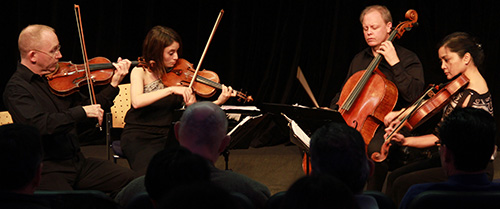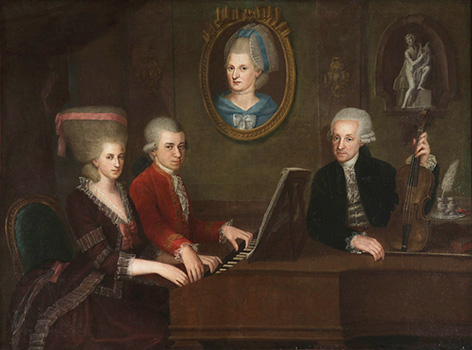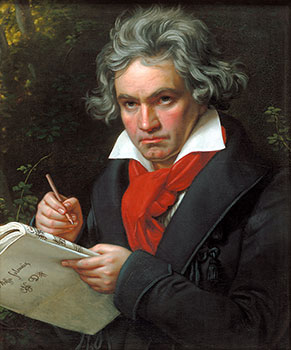Learn

Definitions
The Classical period lasted from 1750 until around 1820. Classical music has a lighter, clearer texture than Baroque music and is less complex. Classical music has two distinct meanings:
- One definition is the general term given to all orchestral music. This is probably what you think about when you hear the term, classical music.
- The other definition is music from the Classical Period. This is the type of music we will cover in this lesson.

Music in Society
During the Classical Period, people were very interested in the idea of ancient Greece and Rome. There was a lot of social change during this time, including the American Revolution (1775 - 1783) and French Revolution (1787 - 1799).
With the revolutions in sight, aristocracy throughout Europe eased rules and taxation, leading to increased incomes and the rise of the middle class. The middle class wanted luxuries previously enjoyed mostly by the aristocracy including theatre and music. While it was still common for composers to rely on the courts and the church for careers, it was now possible for composers to earn a living by publishing compositions and having their works performed in public concerts.
Many in the middle class wanted their children to study in music, as well, and they often had musical instruments in their homes. This lead to the rise of the amateur musician during this period. In addition to writing grand pieces for aristocractic and religious events, some composers also wrote music that was easy enough for amateur musicians to play at home.
The main center of music during this period was Vienna, Austria. Because of this, music of this period is often referred to as the Viennese style of music.

Musical Characteristics
The Classical Period was a time of great achievement in music. Composers rebelled against the complex polyphonic two or more simultaneous lines of independent melody music that had been popular during the Baroque period. They wrote homophonic music, which is music that has a distinct melody and accompaniment. This led to the growth of new forms such as the sonata and symphony. Opera was also very popular.
The string quartet, which consists of two violins, a cello, and a viola playing chamber music, was popular as well. The abilities of individual singers and musicians took center focus.

A string quartet with the two violins on the left, the cello, and the viola on the far right. Image by Ching is licensed under CC BY 2.0.

Important Composers
Many of the most famous and enduring works in Western music were written during this period. Important composers included the following masters:
Haydn
Franz Joseph Haydn (1731 - 1809) was an innovative and prolific composer of the time. He is considered the "father of the modern symphony." During his life, he composed 106 symphonies, 15 operas, concertos for every known instrument of the day, string quartets, piano sonatas, as well as others. His most famous compositions include the Trumpet Concerto in E♭ (or Trumpet Concerto in E Flat), and his Symphony No. 94. This symphony is commonly called the "Surprise Symphony" because the music gradually got quiet until the last note which was really loud. It startled audiences and earned the nickname.
Listen to the first movement of his Trumpet Concerto in E♭ (15:26) below.
Trumpet Concerto in E flat major, Hob. VIIe 1 performed by Matt Dempsey has been released into the public domain.

Portrait of Joseph Haydn by Thomas Hardy, oil on canvas, 1791, © Royal College of Music. See larger version here.
Mozart
Wolfgang Amadeus Mozart (1756 - 1791) was another of the most famous classical composers. He wrote around 600 works, including symphonies, operas, chamber music, piano music, and choral music. His most famous compositions are:
- Eine Kleine Nachtmusik (A Little Night Music) from 1787,
- Le Nozze di Figaro (The Marriage of Figaro) from 1786,
- Don Giovanni from 1787, and
- Die Zauberflote (The Magic Flute) from 1791.

This portrait of the Mozart family shows Wolfgang (second from left) with his sister Maria Anna (far left), a portrait of his mother Anna Maria, and his father Leopold (right). Johann Nepomuk della Croce painted it circa 1780, and it resides in the Mozarteum University Salzburg. Image is in the public domain. See larger version here.
Listen to the following examples of Mozart's music: Symphony 40, Movement 1 (8:13) and Overture to Don Giovanni (6:49).
(O) Symphony 40 g-moll, KV 550 - 1. Molto allegro (conductor: Simon Schindler, ensemble: Fulda Symphonic Orchestra, date: 2001) is licensed under EFF Open Audio License 1.
(O) Overture to Don Giovanni, K. 527 (conductor: Simon Schindler, ensemble: Fulda Symphonic Orchestra, date: 2000) is licensed under EFF Open Audio License 1.
Next, watch the video The Classical Period: Mozart and Haydn (15:31) for an in-depth discussion of the Classical Period and the works of Mozart and Haydn.
Open The Classical Period: Mozart and Haydn in a new tab
Beethoven
Ludwig Van Beethoven (1770 - 1827) is one of the most famous and influential composers of all time. His work bridged the Classical and Romantic periods. His works are considered the apex of Classical forms such as the symphony, but the emotional nature of his work and his "all or nothing" approach to his artistry align him with the beginnings of Romanticism (the following musical period). His most famous compositions include Ode to Joy (Symphony No. 9), Für Elise, Symphony No. 5, and Moonlight Sonata.

Portrait of Ludwig von Beethoven when composing the Missa Solemnis by Joseph Karl Stieler, 1820. Image is in the public domain. See larger version here.
Listen to the following examples of Beethoven's works: Symphony No. 6 (5:37) and Für Elise (2:56).
Symphony no. 5 in Cm, Op. 67 - III. Allegro by Skidmore College Orchestra has been released into the public domain.
This rendition of Für Elise performed by V. Gao is licensed under CC0 1.0.
Next, watch the Fargo-Moorhead Symphony Orchestra perform Symphony No. 9 by Ludwig van Beethoven. This piece is also recognized world wide as "Ode to Joy." From Beethoven's final complete symphony, completed in 1824, this masterpiece is considered to be one of the best-known pieces of classical music in the Western world. Among critics it is arguably among Beethoven's greatest works and possibly the greatest piece of music ever written.
Open FM Symphony Orchestra Young People's Concert: Symphony No. 9 in a new tab
Lastly, watch The Genius of Beethoven (9:20) to learn more about him as a composer.
Open The Genius of Beethoven | Music Arts Toolkit in a new tab

